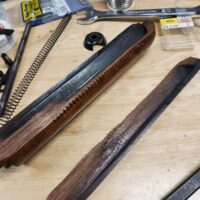The forearm split on a family rifle and I would like to fix it. I need to glue wood to metal, what is a good glue/epoxy to do this?
IDO » Forums » Fishing Forums » General Discussion Forum » Which glue?
Which glue?
-
 Tom schmitt
Posts: 1046September 17, 2023 at 9:01 am #2224669
Tom schmitt
Posts: 1046September 17, 2023 at 9:01 am #2224669I think you may want to recheck the way your rifle is assembled.
I rather doubt the wood is supposed to be glued to the metal.
A good epoxy would be the best way to glue the wood, but not to the metal. TH
Posts: 603September 17, 2023 at 9:45 am #2224690
TH
Posts: 603September 17, 2023 at 9:45 am #2224690Small cracks in gun stock wood that you are trying to keep from showing do well with cyano glues (superglue).
September 17, 2023 at 3:31 pm #2224722The forearm split on a family rifle and I would like to fix it. I need to glue wood to metal, what is a good glue/epoxy to do this?
What type of gun is this?
Grouse
 jwellsy
Posts: 1726September 17, 2023 at 6:53 pm #2224755
jwellsy
Posts: 1726September 17, 2023 at 6:53 pm #2224755Wood to what metal, a sling screw?
Something doesn’t sound right.
Take a couple pics. duh queen
Posts: 547September 18, 2023 at 11:55 am #2224871
duh queen
Posts: 547September 18, 2023 at 11:55 am #2224871It’s NOT glued to the barrel. The forearm covers the gas ports that work the SA action. Do Not Glue It!
 Brittman
Posts: 2242September 18, 2023 at 12:56 pm #2224883
Brittman
Posts: 2242September 18, 2023 at 12:56 pm #2224883Glue on split wood does not always work well. Too little adhesive and the bond is poor … too much and the part changes size. Sometimes the wood recracks parallel to original repair.
Using a thin mesh support may be a better alternative. It spreads out the force on the part.
Even better is to find the replacement part. Most stocks and forearms can be found … often for a good price.
September 18, 2023 at 4:35 pm #2224919I would use wood glue, lightly applied to both sides, clamp for 24 hours.
September 18, 2023 at 5:12 pm #2224922It’s NOT glued to the barrel. The forearm covers the gas ports that work the SA action. Do Not Glue It!
I don’t see where he ever said he was gluing the forearm to the gun.
He ONLY said wood to metal. I have seen metal “splints” inlayed on the hidden side. I’ve also “splinted” a crack and missing wood by inlaying a brass plate into the exposed side of the wood. It looks “decorative” but is also functional in reinforcing the wood. I used epoxy, don’t know if that was the best choice but it’s what I used.
September 19, 2023 at 10:23 am #2225012Call Laibs Gunsmithing in Spicer,MN. They are a Remington repair specialist.
September 19, 2023 at 10:04 pm #2225142Here you can see where the factory had glued the insert to the stock. Every gas operated gun I have is like this in some way. I went with an epoxy, we’ll see how it turns out.
September 20, 2023 at 8:10 am #2225161I would use wood glue on the wood to wood and epoxy on the wood to metal… would you ?
 September 20, 2023 at 1:40 pm #2225222
September 20, 2023 at 1:40 pm #2225222New wood and stock are not expensive.
Won’t have the same patina and memories as the original. OP said is is a family gun.
September 21, 2023 at 7:51 am #2225352I tried it on my old 30:06, the big crack down the middle doesn’t look very good either.
September 21, 2023 at 8:08 am #2225353Actually an old gun should be repaired… only adds to the story/heirloom. New parts… not so much. Just my opinion.
 Jimmy Jones
Posts: 3336September 21, 2023 at 8:16 am #2225354
Jimmy Jones
Posts: 3336September 21, 2023 at 8:16 am #2225354I’d put a release agent on the metal parts as it sits in the picture, being very careful to keep it off the wood. Then I’d do an epoxy repair with a slow setting epoxy. Any visible “squeeze-out” can be wiped off with a dry cloth or paper towel while still un-set, then an alcohol dampened soft cloth can be rubbed over the area to remove any thin smears of epoxy, again while still un-set.
I’d apply some painter’s tape on the wood where I intended to wrap some duct tape around the parts to act as clamping. The duct tape directly on the wood might remove some of the finish when pulled off but the painter’s tape will let you reef down on the duct tape and will not take any finish up with it when you remove it.
You must be logged in to reply to this topic.
